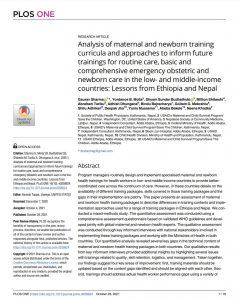
Abstract
Program managers routinely design and implement specialised maternal and newborn health trainings for health workers in low- and middle-income countries to provide better-coordinated care across the continuum of care. However, in these countries details on the availability of different training packages, skills covered in those training packages and the gaps in their implementation are patchy. This paper presents an assessment of maternal and newborn health training packages to describe differences in training contents and implementation approaches used for a range of training packages in Ethiopia and Nepal. We conducted a mixed-methods study. The quantitative assessment was conducted using a comprehensive assessment questionnaire based on validated WHO guidelines and developed jointly with global maternal and newborn health experts. The qualitative assessment was conducted through key informant interviews with national stakeholders involved in implementing these training packages and working with the Ministries of Health in both countries. Our quantitative analysis revealed several key gaps in the technical content of maternal and newborn health training packages in both countries. Our qualitative results from key informant interviews provided additional insights by highlighting several issues with trainings related to quality, skill retention, logistics, and management. Taken together, our findings suggest four key areas of improvement: first, training materials should be updated based on the content gaps identified and should be aligned with each other. Second, trainings should address actual health worker performance gaps using a variety of innovative approaches such as blended and self-directed learning. Third, post-training supervision and ongoing mentoring need to be strengthened. Lastly, functional training information systems are required to support planning efforts in both countries.